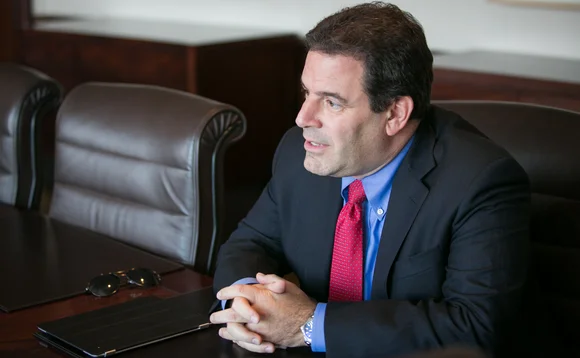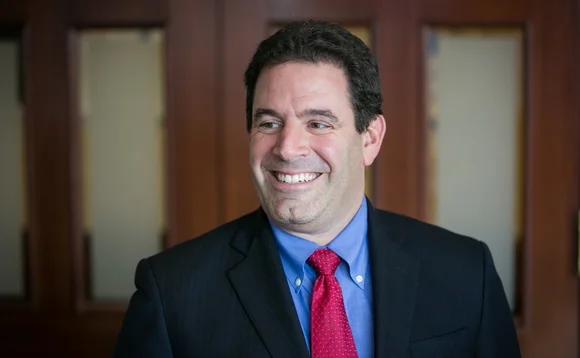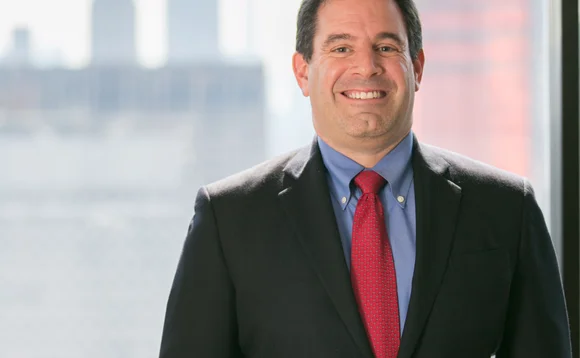KKR's Colorful Personality: CIO Ed Brandman






His is that one desk—every firm has one—where colleagues naturally congregate for a laugh. Lately, Ed Brandman keeps a set of juggling balls close at hand for visitors to try out—he’s mastered them—right next to the M&M’s. But on this particular morning, that show must wait. First, an explanation is warranted by the CIO’s more obvious curiosity for the day: Brandman’s choice of tie, which is a present from, and features a portrait of, his daughter Kyra, given in honor of their mutual birthday—which, as it happens, is today.
He’s made an annual tradition of wearing it to mark the occasion. “I just can’t disappoint her,” he says, beaming.
Brandman’s levity and conversation-starting neckwear aside, his role only grows greater at KKR, a famously hard-nosed shop once known simply by its founders’ surnames—Kohlberg, Kravis, and Roberts—that now manages $94.3 billion in combined assets. In fact, as co-founder Henry Kravis, another outsized personality and a frequent visitor to Brandman’s office, can tell you, Brandman’s gregarious veneer masks an entrepreneurialism that makes him typical KKR material. He just happens to be a technologist.
California Dreamin’
With an accent that proudly establishes his New Jersey roots, Brandman’s real break into IT leadership came in the late 1990s when, while working for JPMorgan’s equities trading operations, he assembled a small team of technologists willing to split for the West Coast of the US. In the midst of the first dot-com boom, a former JPMorgan trader had pried Brandman and his flock away for Robertson Stephens, a member of the so-called Four Horsemen boutique brokerages for technology start-ups. One of Silicon Valley’s sterling sell-side partners at its height, Robertson underwrote 74 initial public offerings (IPOs) between 1999 and 2000. In 2013, the number of US IPOs totaled 222, the most since then. These, in other words, were high times.
While heading up Robertson Stephens’ IT, Brandman managed systems across business lines, from trading and corporate finance to research and advisory. But four years of working with Mike McCaffery—then the bank’s CEO and now chairman at $15 billion California-based hedge fund Makena Capital—really set the stage for his role in private equity (PE) later on.
“The secret sauce in the technology is in tagging data we take in. You want to leverage information as much as possible, but respect the walls in terms of the public and private opportunities, without building those walls too high.”
“Previous to that, I really didn’t have an appreciation for what private equity or venture capital was, and the notion of investing in new businesses, growing them, and eventually watching their senior executives become private clients,” Brandman says. “With Mike, I saw that full lifecycle. It probably also gave me the conviction to do what came next, which might not have been there otherwise.”
What came next was that Robbie Stephens, as it was known colloquially, shuttered in 2002 after the dot-com bubble burst, and Brandman ventured out on his own. He and his team took the bank’s proprietary electronic order routing and execution workstation, hopingly branded it Renaissance Trading Technologies, and spun it off. The platform, which effectively addressed Regulation NMS with early FIX messaging engines, quickly gained industry attention and was sold a few years later to Nyfix, which subsequently became property of NYSE Euronext.
Natural Candidate
Moving back east and taking on consulting for a few years as his kids grew up, Brandman found himself at PricewaterhouseCoopers. In 2007, a recruiter came asking for Brandman’s suggestions around the industry for a new position, managing KKR’s then-relatively light IT footprint. “Candidly, at first I wasn’t sure what a CIO would do here,” he says. But the more he thought of his time in California, as well as of his exposure to accounting and tax issues at PwC—KKR was in the midst of its first S-1 filing with the Securities and Exchange Commission (SEC), preparing to go public—the more it made a bit of sense.
Brandman came back with the best possible candidate: himself. As for his initial expectations? Well, they proved spectacularly and beautifully wrong.
“In my wildest imagination, I couldn’t have foreseen how it has ended up,” he says. “What I didn’t see in 2007 was KKR, and its peers for that matter, perched on the brink of becoming global alternative asset managers, beyond just pure-play private equity to a much more diversified portfolio of products, clients, and assets. Mostly, I thought I would be solving for smoother handling of KKR’s high-touch relationships. Instead, it’s been re-inventing a platform to deal with the same operational and legal complexities that large investment banks face—in terms of entities, tax structures, the way clients now invest, and the way our funds themselves operate—all with a much smaller staff.”
Strong Conviction
Like its CIO and his tie, KKR is a family affair, and has always balanced both coasts—dating back to Kravis’ cross-country drives to work in New York during summers off from Claremont College, near Los Angeles. Kravis’ cousin, George Roberts, still pilots the firm’s influential outpost in Menlo Park, Calif., which Brandman visits regularly.
Growing out of Bear Stearns in 1976, KKR has run the gamut from early bootstrap acquisitions and pioneering the leveraged buyout—earning it the titular role in the book and subsequent film Barbarians at the Gate—to propping up more recent structures like private investment in public equity (PIPEs), and owning stakes in everything from Alliance Boots and Oriental Brewery to Sun Microsystems and SunGard.
Whereas public trading generally implies a fairly short investment time horizon, managing a private equity fund is like putting a child through school—and takes almost as long.
From early due diligence onward, the funds spend five years invested and then another five to seven being harvested, either through strategic divestment or public offerings. Superior technology, therefore, will never replace superior judgment at KKR, but the former can certainly help catalyze the latter. As Brandman immediately found upon arriving, there is no lack of data to clean, consume, and disseminate in the process. The difference is simply in the nature of the information.
“It’s a distinction not well-understood outside the industry,” he explains. “We make money on a multiple of capital, so we’re not focused on the small shifts that move public markets every day. The thing that is so different about private equity is the level of detail you can get into around what makes companies tick, and much of this is non-public information—you’re really peeking behind the curtain, talking to suppliers and channeling partners. Ultimately, when Henry, George and the investment committee decide to commit capital, they need to have really strong conviction.”
Tipping Point
KKR was approaching a tipping point in 2007, when it owned about 40 companies—the firm’s traditional PE investments now span twice that number. Back then, all of those companies’ monthly performance data was coming in by spreadsheet, in different formats, and it was just about there that any automation would stop. “A small army of investment professionals and our finance team would toil to get that data compiled. Some parts of the process would take six weeks to pull together,” Brandman recalls.
Private equity, after all, was operationally old-fashioned at the time, and no one expected otherwise—almost no one, that is.
Both for internal efficiency’s sake and in prudent anticipation of heightened limited partner (LP) investors’ expectations, Brandman, CFO Bill Janetschek, and portfolio management committee (PMC) head Paul Raether agreed the impetus for wholesale technology change was there. It just needed to be properly articulated. Along with Assunta Gaglione and Doug Grossman—trusted hands from his days at JPMorgan—Brandman developed the IT transformation plan in 2009. Janetschek and Raether brought back a strategy for buy-in on the business side. “And an awful lot comes with those two guys saying, ‘Here’s how this is going to work,’” Brandman stresses.
Depth of Detail
The resulting portfolio reporting platform—a proprietary front-end initially built on top of SunGard’s Investran—is still at the core of how the firm manages data intake, exports its funds’ performance metrics, and feeds the firm’s “mountain of data,” as Brandman puts it, into an increasingly wide array of predictive analytics. Today, many general partner firms are building something in its likeness.
Floating between Investran and the firm’s Black Mountain Systems-provided credit platform, the in-house build is particularly valuable in parsing out what kinds of information should—or legally cannot—travel from one strategy to another. “The secret sauce in the technology is in tagging data we take in,” Brandman says. “You want to leverage information as much as possible, but respect the walls in terms of the public and private opportunities, without building those walls too high. That’s a big part of the equation.”
Once consumed, the data travels to where it’s best applied. For example, Henry McVey and the global macro team use it to validate or discredit other views they get from public research providers. “When the credit crisis was still in its last throes, we could look at debt schedules faster to figure out when an optimal time was to refinance; likewise, we can look at retail trends in Europe or Asia—credit card data, for example—to validate what is happening to support the investment team’s thesis,” Brandman continues. “If a company isn’t hitting its budget, if there’s a cushion issue with a loan covenant, or an opportunity where revenue is suddenly expanding at an accelerated pace, all of that data comes front and center for the PMC. Ultimately, it’s not the decision-making unto itself—this isn’t high-frequency trading. But it allows us to make decisions faster.”
The same is true of KKR’s fast growing fund-of-fund and credit businesses, covering high-yield bonds, leveraged loans, and special situations. A busy day for KKR’s credit team will see only 20 to 30 trades, but their desks are always humming because in these esoteric asset classes, allocation methodology and portfolio rebalancing are crucial. The required depth of detail, therefore, is the same.
“A lot of clients will be invested both in these and traditional private equity, so even if we think of them as distinct, we need to be able to bring the whole story to them,” Brandman says. “When you’re buying a loan, it’s a legal contract tied to bank debt, meaning you have to understand the EBITDA (earnings before interest, taxes, depreciation, and amortization) and other revenue calculations tied to it. Like in traditional private equity, you’re at the top of the capital structure, so all of those metrics matter when you own these types of assets.”
Capstone Projects
Indeed, facing outward is the next challenge, not just for KKR but also for the increasingly diversified and competitive private equity space, and the firm continues to aim out in front of the pendulum swing that has moved swiftly toward LP transparency in recent years.
“A lot of the data requested now by LPs like institutional investors and pension funds is not just on fund-level performance, like in the past, but on details related to sector exposure and individual companies. The platform has given us the framework to start pushing that data out, and also to be a GP supporter of the Institutional Limited Partner Association (ILPA) principles,” Brandman explains. As with early FIX protocols more than a decade earlier, he has also been active from the start in AltExchange, an industry group of both GPs and LPs seeking to build a standardized messaging taxonomy—much like KKR did internally—that will enable greater automated reporting across the space. Its first stage was finished off this January, and is now in the early stages of implementation.
Still more unique, however, is Brandman’s additional role as advisor to the firm’s portfolio companies. “That’s where I get to wear different hats,” he says. “In concert with our Capstone group, KKR’s arm focused only on operations optimization, we run an annual summit for their CIOs and CTOs. I sit on the board of one of the portfolio companies—market data hygiene provider Ipreo—and I’m often involved in due diligence when we’re looking to invest in others. Technology is critical to so many of them, and they all have their own IT organizations, of course. But most often, and interestingly, I still find myself telling them, ‘You shouldn’t be in the core infrastructure business. Leave that up to someone else. Stick to your front-end apps.’”
Talking Shop
One gets the feeling Brandman could talk shop all day long, and that’s not a bad thing. Luckily, he’s got a willing—if notable—ear. “Henry Kravis will come to me asking questions about information security, cloud, or mobile, and really get into the weeds on that stuff, just as he does with our investments,” he says of KKR’s co-founder. “He’ll catch me at lunch and ask what I think about what Cisco’s doing, and it’s not merely a high-level conversation. He has very specific ideas, and for me, that’s pretty cool.”
As any good entertainer or chief technologist knows, that’s the benefit of always keeping them wanting more. “At KKR, it’s like drinking from a hydrant if you’re not careful. As I tell our new hires, it’s not pretty when you pop the cap off. So many good ideas come out, but just as quickly comes the demand that you execute on them,” Brandman says.
That’s sage—even serious—advice, from someone who’s been there and done that.
ED BRANDMAN FUNDAMENTAL DATA
Name: Ed Brandman
Age: 45
Title: Managing director and CIO
Assets Under Management: $94.3 billion
Number of IT Staff: 60
Education: BA in Political Science from Rutgers University
Hobbies: Amateur magician
IT AT KKR
- Biggest technology challenge: the rapid expansion of the business over the past five years, especially into new alternative asset classes, and creating a high-touch service model.
- Notable technology accomplishments: Investran for all private equity and energy funds; a proprietary PE portfolio reporting system for all 90 companies and monthly business analytics used by portfolio management committee; and Black Mountain Systems for all trade and risk in the credit business. The biggest accomplishment by far is a single set of systems, with no overlap or duplication. Brandman says he got lucky and got to create it all from scratch in the past seven years.
- Technologies currently under evaluation: Amazon EC2 for production systems, currently in development and quality assurance; Workday for human resources; Advent Geneva for credit PE portfolio accounting; and mobile workbench tools to improve access to data for people on the road using Apple iPhones and iPads.
- IT wish list: infrastructure-as-a-service, fully integrated public and private data for the ultimate set of analytics, and easier tools for designing enterprise mobile systems.
Only users who have a paid subscription or are part of a corporate subscription are able to print or copy content.
To access these options, along with all other subscription benefits, please contact info@waterstechnology.com or view our subscription options here: http://subscriptions.waterstechnology.com/subscribe
You are currently unable to print this content. Please contact info@waterstechnology.com to find out more.
You are currently unable to copy this content. Please contact info@waterstechnology.com to find out more.
Copyright Infopro Digital Limited. All rights reserved.
As outlined in our terms and conditions, https://www.infopro-digital.com/terms-and-conditions/subscriptions/ (point 2.4), printing is limited to a single copy.
If you would like to purchase additional rights please email info@waterstechnology.com
Copyright Infopro Digital Limited. All rights reserved.
You may share this content using our article tools. As outlined in our terms and conditions, https://www.infopro-digital.com/terms-and-conditions/subscriptions/ (clause 2.4), an Authorised User may only make one copy of the materials for their own personal use. You must also comply with the restrictions in clause 2.5.
If you would like to purchase additional rights please email info@waterstechnology.com
More on Emerging Technologies
Bloomberg rolls out GenAI-powered Document Insights
The data giant’s newest generative AI tool allows analysts to query documents using a natural-language interface.
Tape bids, algorithmic trading, tariffs fallout and more
The Waters Cooler: Bloomberg integrates events data, SimCorp and TSImagine help out asset managers, and Big xyt makes good on its consolidated tape bid in this week’s news roundup.
DeepSeek success spurs banks to consider do-it-yourself AI
Chinese LLM resets price tag for in-house systems—and could also nudge banks towards open-source models.
Standard Chartered goes from spectator to player in digital asset game
The bank’s digital assets custody offering is underpinned by an open API and modular infrastructure, allowing it to potentially add a secondary back-end system provider.
Saugata Saha pilots S&P’s way through data interoperability, AI
Saha, who was named president of S&P Global Market Intelligence last year, details how the company is looking at enterprise data and the success of its early investments in AI.
Data partnerships, outsourced trading, developer wins, Studio Ghibli, and more
The Waters Cooler: CME and Google Cloud reach second base, Visible Alpha settles in at S&P, and another overnight trading venue is approved in this week’s news round-up.
Are we really moving on from GenAI already?
Waters Wrap: Agentic AI is becoming an increasingly hot topic, but Anthony says that shouldn’t come at the expense of generative AI.
Cloud infrastructure’s role in agentic AI
The financial services industry’s AI-driven future will require even greater reliance on cloud. A well-architected framework is key, write IBM’s Gautam Kumar and Raja Basu.







